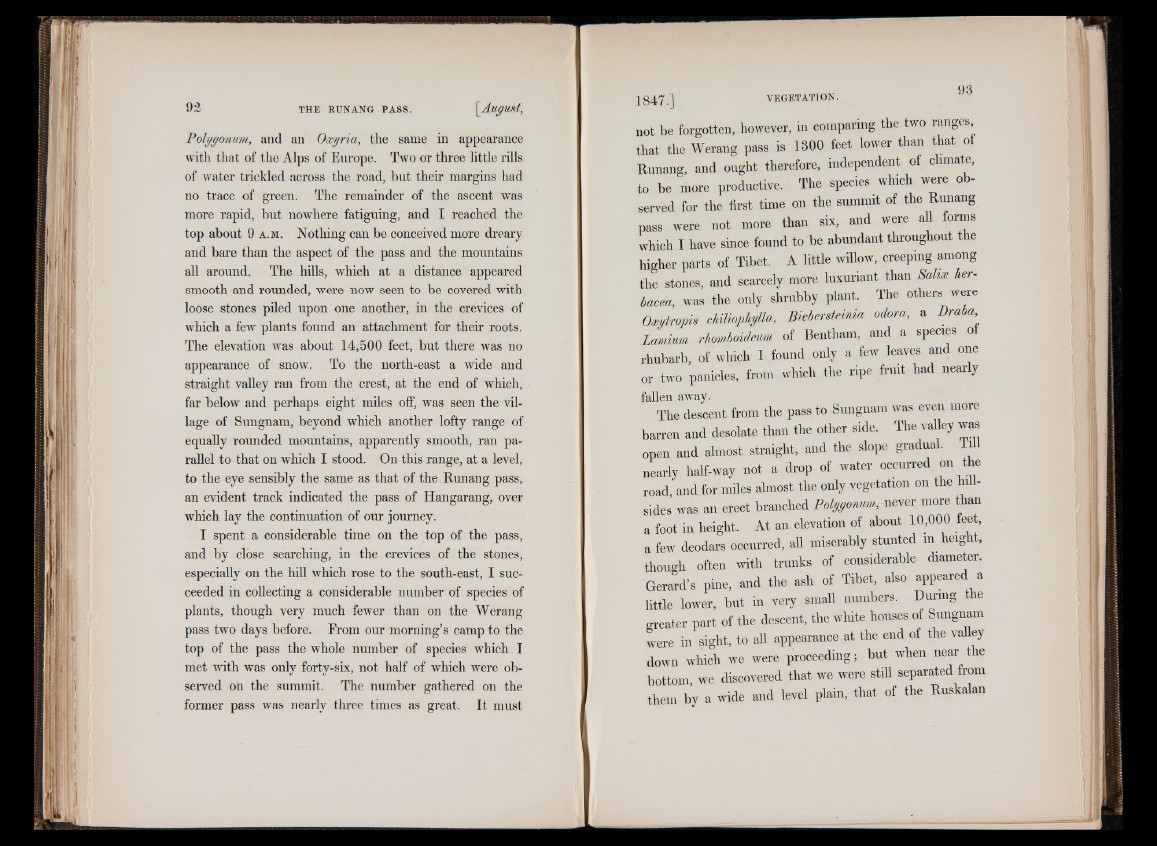
Polygonum, and an Oxyria, the same in appearance
with that of the Alps of Europe. Two or three little rills
of water trickled across the road, hut their margins had
no trace of green. The remainder of the ascent was
more rapid, hut nowhere fatiguing, and I reached the
top about 9 a .m . Nothing can be conceived more dreary
and hare than the aspect of the pass and the mountains
all around. The hills, which at a distance appeared
smooth and rounded, were now seen to he covered with
loose stones piled upon one another, in the crevices of
which a few plants found an attachment for their roots.
The elevation was about 14,500 feet, but there was no
appearance of snow. To the north-east a wide and
straight valley ran from the crest, at the end of which,
far below and perhaps eight miles off, was seen the village
of Sungnam, beyond which another lofty range of
equally rounded mountains, apparently smooth, ran parallel
to that on which I stood. On this range, at a level,
to the eye sensibly the same as that of the Runang pass,
an evident track indicated the pass of Hangarang, over
which lay the continuation of our journey.
I spent a considerable time on the top of the pass,
and by close searching, in the crevices of the stones,
especially on the hill which rose to the south-east, I succeeded
in collecting a considerable number of species of
plants, though very much fewer than on the Werang
pass two days before. From our morning’s camp to the
top of the pass the whole number of species which I
met with was only forty-six, not half of which were observed
on the summit. The number gathered on the
former pass was nearly three times as great. It must
not be forgotten, however, in comparing the two ranges
that the Werang pass is 1300 feet lower than that ot
Runang, and ought therefore, independent of climate,
to be more productive. The species which were observed
for the first time on the summit of the Runang
pass were not more than six, and were all forms
which I have since found to be abundant throughout the
higher parts of Tibet. A little willow, creeping among
the stones, and scarcely more luxuriant than Sahx her-
bacea, was the only shrubby plant. The others were
Oxytropis chiliophylla, Bieberstemia odora, a Dr aba
Lamium rhomboideum of Bentham, and a species ot
rhubarb, of which I found only a few leaves and one
or two panicles, from which the ripe fruit had nearly
fallen away.
The descent from the pass to Sungnam was even more
barren and desolate than the other side. The valley was
open and almost straight, and the slope gradual. Till
nearly half-way not a drop of water occurred on the
road and for miles almost the only vegetation on the hillsides’
was an erect branched Polygonum, never more than
a foot in height. At an elevation of about 10,000 leet,
a few deodars occurred, all miserably stunted m heigh ,
though often with trunks of considerable diameter.
Gerard’s pine, and the ash of Tibet, also appeared a
little lower, but in very small numbers. During the
greater part of the descent, the white houses of Sungnam
were in sight, to all appearance at the end of the valley
down which we were proceeding; but when near the
bottom, we discovered that we were still separated from
them by a wide and level plain, that of the Ruskalan